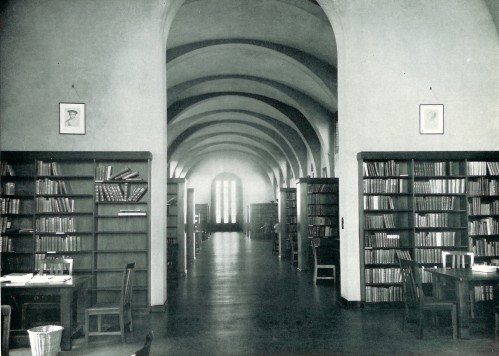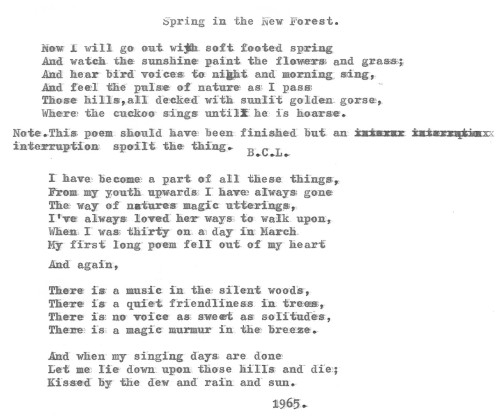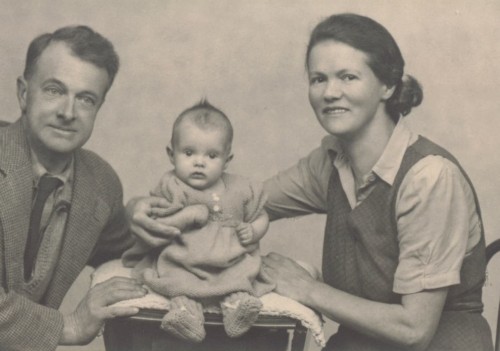Despite the 1930s being coloured with the economic depression, the College managed to achieve stability and progress. Treasury grants were raised again by the Grants Committee, and student numbers reached a peak at 474 in the academic year 1931-2, and were to reach 500 in the session 1932-3. The opening of New Hall was approaching, and a sense of self-assurance and shared determination infused on campus amongst staff and students.
![Pages on New Hall from Booklet for University College, Southampton halls of residence, c.1930 [MS 224 A908/5, pp. 12-13]](https://specialcollectionsuniversityofsouthampton.files.wordpress.com/2019/03/official-new-hall-of-residence-for-men-.jpg?w=500)
New Hall, University College, Southampton Halls of Residence, c.1930 [MS224 A908/5, pp. 12-13]
As a result of generous benefactions, the College was able to construct and develop better facilities for its growing disciplines. At first housed in one small room in the main building and afterwards in two huts, Zoology was moved to the “Science Block” after a gift of £8000 was made by an anonymous donor. Completed in 1931, the building provided facilities for work that was impossible to conduct in the huts. The building also enabled the College to accept treasured zoological and geological collections, such as the Cotton Collection of British Birds, which was formerly housed by the Corporation of Winchester and transferred in 1936.
![Corridor in the zoological laboratory from the University College Southampton Prospectus, 1934 [MS 224/22]](https://specialcollectionsuniversityofsouthampton.files.wordpress.com/2019/03/official-zoological-laboratory-.jpg?w=500)
Corridor in the zoological laboratory, University College Southampton Prospectus, 1934 [MS224/22]
The College was also involved in city projects, which in turn led to the development of its courses. An example was the Dock Extension Scheme project. This involved construction on land regained from the higher part of Southampton Water of those docks which now expand along to Millbrook Point. The extension was completed in 1934 by many engineers who were former students of the College. It was expected that this docks extension would lead to more shipping companies using the port, and therefore more projects for the College to supply young engineers. Professor Eustice’s retirement as Chair of Engineering in 1930 was taken by the College as an opportunity to think about the future of its Engineering faculty, and to create a clear strategy, in time for Professor Eustice’s successor.
![Southern Railway – Southampton Docks. Proposed Dock Extensions – Western Shore, Wessex, Volume 2, 1931-33 [LD 789.9 Univ Coll.]](https://specialcollectionsuniversityofsouthampton.files.wordpress.com/2019/03/official-wessex-proposed-dock-extension.jpg?w=500)
Southern Railway – Southampton Docks. Proposed Dock Extensions – Western Shore, Wessex, Volume 2, 1931-33 [LF789.9 Univ. Coll.]
Southampton’s location near large engineering works made it a suitable place as a hub for engineering studies in the south of England. In the interests of engineering education, it would be beneficial for the training department to be part of a Higher Education institution, where it could be in close proximity to pure sciences with which engineering had numerous connections. Moreover, the College possessed the only engineering department of Higher Education standard on the south coast. This led to the Chair of Engineering’s salary being substantially increased, and an agreement that £5000 would be spent on equipment during the next two or three years, with a similar amount being saved for further accommodation.
The next Chair of Engineering appointed in 1931 was Wing-Commander T.R. Cave-Browne Cave. His career experience included serving in the Navy as an engineer-officer, and transferring to the Royal Naval Air Service and the Royal Air Force. He also had been responsible for the design, construction, and trial of non-rigid airships, and had conducted research at the Admiralty, and the Air Ministry, as well as serving on the Aeronautical Research Committee. Alongside his Chair of Engineering duties, Cave-Brown-Cave gave informal talks on aeronautical engineering at the halls of residence. Here is an account of a talk he gave at Stoneham House, featured in an issue of the West Saxon.
“We were fortunate last term in hearing Commander Cave-Brown-Cave give us what amounted to a racy and entertaining history of airships in England… I remember most vividly the thrilling account of the destruction of the R 33 over the Humber, the enthusiastic description of speed trials over the Channel in the R 100, and the wonderful impression of speed to be gained when racing only eighty feet above the clouds.” [The West Saxon, Summer Term 1931, p.91]
![Letter written by Commander Cave-Brown-Cave, 19 May 1936 [MS 1 4/126]](https://specialcollectionsuniversityofsouthampton.files.wordpress.com/2019/03/official-cave-brown-cave-letter.jpg?w=500&h=617)
Letter written by Commander Cave-Brown-Cave, 19 May 1936 [MS1/4/126]
The effects of the 1930s economic crisis led to the College experiencing a temporary drop in the grants received from the local authorities and the Board of Education, causing a small reduction in income. Cuts were also made to staff salaries. The biggest blow to the College, however, was the sudden dip in the number of students due to the changed policy of the Board of Education, and the damage this incurred on the College revenue. In 1929 a 5-year agreement was made between the Board of Education and the College over the supplementary two-year students. Before the crisis, the total numbers accepted to the Education Department was 375 (200 four-year, 150 two-year and 25 one-year postgraduate students), and this number had been almost fully reached. As a result of the economic crisis however, the Board first reduced the permitted total by 12.5%. They then announced in 1932 that under the cu
rrent situation, the agreement on the College admitting two-year certificate students until 1934 would have to be terminated, except on conditions that hindered rather than benefitted the College.
![Faculty of Education course of study slip, 1933-1934 [MS 104 LF780 UNI 5/374/122]](https://specialcollectionsuniversityofsouthampton.files.wordpress.com/2019/03/official-faculty-of-education-certificate-second-year.jpg?w=500)
Faculty of Education course of study slip, 1933-1934 [MS104 LF780 UNI 5/374/122]
To meet this situation several staff appointments were terminated. Full-time members of staff were asked to take evening classes for which part-time teachers had been previously employed, cuts were made on funds for apparatus and equipment, and the administrative personnel was condensed. In spite of all these measures, deficits of £1873, £2882, and £6050 arose in 1933-4 and the two subsequent sessions; and in order to meet bank charges, some of the College’s investments had to be sold.
![Advertisement for University College, Southampton, Wessex, Volume 3, 1933-36 [LD 789.9 Univ Coll.]](https://specialcollectionsuniversityofsouthampton.files.wordpress.com/2019/03/official-university-of-southampton-advert.jpg?w=500)
Advertisement for University College, Southampton, Wessex, Volume 3, 1933-36 [LF789.9 Univ. Coll.]
These deficits were the result of the necessary building programme required to provide the Engineering Department with new facilities, which included lecture rooms, drawing-offices, and workshops. In 1931-2, a new engineering block housing all of these and a new boiler house was constructed. Under a new regulation of London University’s External Council, no candidates for engineering degrees could be admitted to the examination unless they had studied in an approved institution. This meant that the new block required an inspection by London University, to which it passed with flying colours.
![Bay of the engineering laboratories from the University College Southampton Prospectus, 1934 [MS 224/22]](https://specialcollectionsuniversityofsouthampton.files.wordpress.com/2019/03/official-engineering-bay.jpg?w=500)
Bay of the engineering laboratories, University College Southampton Prospectus, 1934 [MS224/22]
The development of the Engineering Faculty included the introduction of the Aeronautical Studies at the College. This was made possible by the development of a wind tunnel in 1934. To begin with, the tunnel was of a temporary nature and housed in an old hut. In 1941, it was rebuilt in more substantial form and filled with modern machinery. Initially, instruction in aeronautical work was provided to students in addition to their normal degree course. As a result of aircraft being increasingly demanded at a fast pace, and the resulting huge development of the mechanical staff of manufacturing companies, there was now an upward need for instruction of a standard, which would qualify students to take the aeronautical papers of the London degree examination. This led to University College Southampton appointing Mr T. Tanner as Lecturer in Aeronautical Engineering in 1936.
![Students studying a model in the 7 x 5 wind tunnel from the University of Southampton 1862-1962 Centenary Appeal booklet [MS224/22 A952/6]](https://specialcollectionsuniversityofsouthampton.files.wordpress.com/2019/03/official-wind-tunnel.jpg?w=500)
Students studying a model in the 7 x 5 wind tunnel, University of Southampton 1862-1962 Centenary Appeal [MS224/22 A952/6]
By 1931 the insufficiency of the library facilities was deemed so great that a special committee of Senate believed it was halting the effectiveness of the College. The state of finances could offer no solution, until a Mr Edward Turner Sims, a member of the Council who died in 1928, left a generous legacy. In his will he expressed his wish that some sort of memorial to him would be placed in the College. Mr Edward Turner Sims’ daughters, Mary and Margaret, made this wish come true by presenting to the College £24,250 for the construction of a library. In October 1935 H.R.H. the Duke of York (later King George VI) opened the Turner Sims Library. Holding a commodious reading room, a stack room for 12,000 volumes, and six seminar rooms for classics, modern languages, English, philosophy, history and economics, the library was an attractive space for students. So distinguished, the library was provided a prized location in the centre part of the main block on Highfield Campus. Soon after, donations were presented to the library, including in 1938 the collection of Claude Montefiore. The donation consisted of 4500 volumes, of which most focused on theology, Judaica, classical texts, and ancient history. This donation would later become part of the
Parkes Library within the Library, which is now one of the largest Jewish documentation centres in Europe.

Interior of the main reading room at Edward Turner Sims Library, c.1938, Wessex, Vol 4, 1937-1938 [LF789.9 Univ. Coll.]
The formation of a School of Navigation had been one of Lyon Playfair’s ideas for the work of the Hartley Institution, and it was finally put into action in 1932, through the Council taking over Gilchrist Navigation School. The Council decided to operate it for an initial 2 years in South Hill. In 1935, the School was made permanent with the support of the local, educational, municipal, and shipping authorities. The appointed Director of the same year was Captain G.W. Wakeford. Restructured and expanded, the School received the recognition of the Board of Trade and the Board of Education. Extending over one year, a residential cadet course was opened in 1937.
![Department of Navigation, Wessex Volume 3, 1933-36 [LD 789.9 Univ Coll.]](https://specialcollectionsuniversityofsouthampton.files.wordpress.com/2019/03/official-wessex-department-of-navigation-1.jpg?w=500)
Department of Navigation, Wessex, Volume 3, 1933-36 [LF789.9 Univ. Coll.]
Despite the development of new facilities, student numbers were falling in the middle and later thirties, and there was a drop in the standard of examination results. Occurring predominantly in the Education Department, where the number of staff members almost matched the number of full-time students, the number of full-time students went from 375 in the session 1934-5 down to 269 in the session 1938-9. Student numbers dipped so low, that the College decided during the session of 1939-40 to have only two halls of residence open – Highfield and Connaught.
![Female residents and sub-warden sat in front of Highfield Hall, 1930-31 [MS 224 A919/1]](https://specialcollectionsuniversityofsouthampton.files.wordpress.com/2019/03/official-highfield-hall.jpg?w=500)
Female residents and sub-warden sat in front of Highfield Hall, 1930-31 [MS224 A919/1]
It should be noted that this fall in students was not specific to the College, but in fact a countrywide problem. Some institutions however, suffered more than others. One general cause of the fall in students that was known to all higher education institutions was that in times of high employment parents preferred their children to grasp employment opportunities when they existed, rather than to spend time on Higher Education.
![Graduates of University College, Southampton, May 1930 [MS224/12 A919/7]](https://specialcollectionsuniversityofsouthampton.files.wordpress.com/2019/03/the-official-1930-graduation.jpg?w=500)
Graduates of University College, Southampton, May 1930 [MS224/12 A919/7]
A Committee was eventually set up to discuss the how the numbers and quality of students could be improved again. They reported in 1939 measures to be taken, which focused on methods of motivating the less reactive students and steps to make the College’s work and resources more widely recognised. The outbreak of World War Two gave little time for these to be put into action however, and the war’s aftermath created a very different situation. Look out for our next Highfield 100 Campus blog post, which will take you through the forties at the University!
![“Southampton War Cry” from the Wessex Student Song Book [MS 224 A917/10]](https://specialcollectionsuniversityofsouthampton.files.wordpress.com/2019/03/the-official-ucs-war-cry.jpg?w=500)
“Southampton War Cry”, Wessex Student Song Book [MS224 A917/10]
![Pages on New Hall from Booklet for University College, Southampton halls of residence, c.1930 [MS 224 A908/5, pp. 12-13]](https://specialcollectionsuniversityofsouthampton.files.wordpress.com/2019/03/official-new-hall-of-residence-for-men-.jpg?w=500)
![Corridor in the zoological laboratory from the University College Southampton Prospectus, 1934 [MS 224/22]](https://specialcollectionsuniversityofsouthampton.files.wordpress.com/2019/03/official-zoological-laboratory-.jpg?w=500)
![Southern Railway – Southampton Docks. Proposed Dock Extensions – Western Shore, Wessex, Volume 2, 1931-33 [LD 789.9 Univ Coll.]](https://specialcollectionsuniversityofsouthampton.files.wordpress.com/2019/03/official-wessex-proposed-dock-extension.jpg?w=500)
![Letter written by Commander Cave-Brown-Cave, 19 May 1936 [MS 1 4/126]](https://specialcollectionsuniversityofsouthampton.files.wordpress.com/2019/03/official-cave-brown-cave-letter.jpg?w=500&h=617)
![Faculty of Education course of study slip, 1933-1934 [MS 104 LF780 UNI 5/374/122]](https://specialcollectionsuniversityofsouthampton.files.wordpress.com/2019/03/official-faculty-of-education-certificate-second-year.jpg?w=500)
![Advertisement for University College, Southampton, Wessex, Volume 3, 1933-36 [LD 789.9 Univ Coll.]](https://specialcollectionsuniversityofsouthampton.files.wordpress.com/2019/03/official-university-of-southampton-advert.jpg?w=500)
![Bay of the engineering laboratories from the University College Southampton Prospectus, 1934 [MS 224/22]](https://specialcollectionsuniversityofsouthampton.files.wordpress.com/2019/03/official-engineering-bay.jpg?w=500)
![Students studying a model in the 7 x 5 wind tunnel from the University of Southampton 1862-1962 Centenary Appeal booklet [MS224/22 A952/6]](https://specialcollectionsuniversityofsouthampton.files.wordpress.com/2019/03/official-wind-tunnel.jpg?w=500)

![Department of Navigation, Wessex Volume 3, 1933-36 [LD 789.9 Univ Coll.]](https://specialcollectionsuniversityofsouthampton.files.wordpress.com/2019/03/official-wessex-department-of-navigation-1.jpg?w=500)
![Female residents and sub-warden sat in front of Highfield Hall, 1930-31 [MS 224 A919/1]](https://specialcollectionsuniversityofsouthampton.files.wordpress.com/2019/03/official-highfield-hall.jpg?w=500)
![Graduates of University College, Southampton, May 1930 [MS224/12 A919/7]](https://specialcollectionsuniversityofsouthampton.files.wordpress.com/2019/03/the-official-1930-graduation.jpg?w=500)
![“Southampton War Cry” from the Wessex Student Song Book [MS 224 A917/10]](https://specialcollectionsuniversityofsouthampton.files.wordpress.com/2019/03/the-official-ucs-war-cry.jpg?w=500)





![Note from Wellington to Collins sending instructions for preparing his room at Walmer Castle, 1838 [MS69/2/15]](https://specialcollectionsuniversityofsouthampton.files.wordpress.com/2019/03/ms69_2_15_crop.jpg?w=320&h=341)
![Red ribbon of the Order of the Bath [MS69/4/11]](https://specialcollectionsuniversityofsouthampton.files.wordpress.com/2019/03/ms69_4_11.jpg?w=500&h=220)
![Recipe for "onion porage" [MS69/4/19]](https://specialcollectionsuniversityofsouthampton.files.wordpress.com/2019/03/ms69_4_19r.jpg?w=287&h=439)
![Illustration of the Duke of Wellington [MS351 A4170/9]](https://specialcollectionsuniversityofsouthampton.files.wordpress.com/2019/03/ms351_6_a4170_9.jpg?w=450&h=353)
![Letter from Gurwood to his mother in which he reports he led the "forlorn hope" at Ciudad Rodrigo, 20 January 1812 [MS321/7]](https://specialcollectionsuniversityofsouthampton.files.wordpress.com/2019/03/ms321_5_20jan1812_0001.jpg?w=425&h=535)
!["Journal du blocure de la place de Barcelonne" [MS360/1]](https://specialcollectionsuniversityofsouthampton.files.wordpress.com/2019/03/ms360_1_f1r_crop.jpg?w=381&h=567)
![Signature of Daniel O'Connell, 1815 [MS64/17/2]](https://specialcollectionsuniversityofsouthampton.files.wordpress.com/2019/03/ms64_17_2_signature_1.jpg?w=400&h=135)
![Letter from Daniel O'Connell to Sir Henry Parnell, 13 June 1815 [MS64/17/2]](https://specialcollectionsuniversityofsouthampton.files.wordpress.com/2019/03/ms64_17_2_cover_crop.jpg?w=500)
![Letter from Simon Bolivar to Lord Wellesley, 22 January 1811 [MS63/9/7]](https://specialcollectionsuniversityofsouthampton.files.wordpress.com/2019/03/ms63972.jpg?w=380&h=435)






![Men's football team, 1953-4 [photo_MS1_7_291_22_4] Men's football team, 1953-4 [photo_MS1_7_291_22_4]](https://live.staticflickr.com/65535/50089268168_f26eed63ef_s.jpg)
![Women's rowing team, 1961-2 [MS1_7_291_22_4] Women's rowing team, 1961-2 [MS1_7_291_22_4]](https://live.staticflickr.com/65535/50090079577_3b7acbde42_s.jpg)
![Men's rugby team, 1953-4 [MS1_7_291_22_4] Men's rugby team, 1953-4 [MS1_7_291_22_4]](https://live.staticflickr.com/65535/50089268523_4f2c587220_s.jpg)
![Women's hockey team, 1953-4 [MS1_7_291_22_4] Women's hockey team, 1953-4 [MS1_7_291_22_4]](https://live.staticflickr.com/65535/50090079692_28114e9c7d_s.jpg)